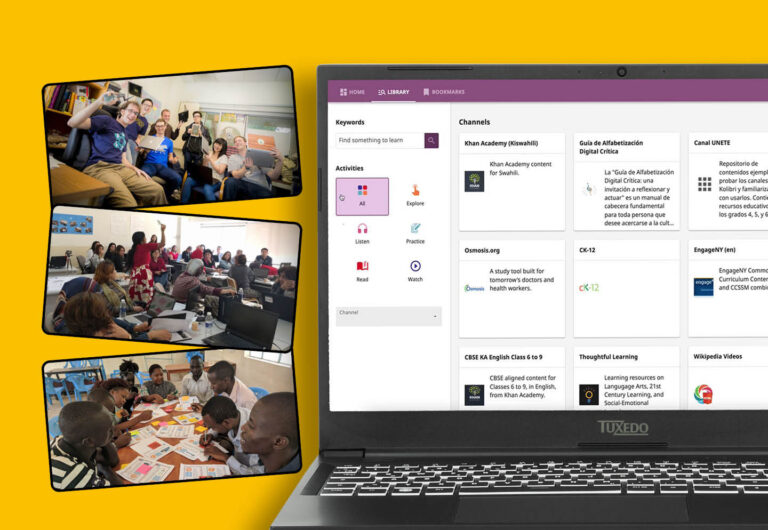Learning Equality: Transforming Education through FOSS

In our series highlighting remarkable FOSS initiatives, we turn our attention to Learning Equality and their transformative platform, Kolibri. This innovative project tackles the critical issue of educational access, bridging the gap for learners in low-resource and disconnected environments. Through our interview, we delve into the vision that drives Learning Equality, the challenges and triumphs of developing Kolibri, and how this platform is reshaping the landscape of digital learning. Join us as we explore how Kolibri is making quality education accessible to all, fostering an equitable world where knowledge knows no boundaries. We asked a few questions to Richard Tibbles, Cofounder and Product Lead from Learning Equality.
Can you describe the inspiration behind Learning Equality and the genesis of the Kolibri platform?
Kolibri is the successor to our original KA Lite platform, the offline version of Khan Academy, which was created after my cofounder Jamie Alexandre was doing an internship at Khan Academy in the summer of 2012. He was inspired by the brand new Raspberry Pi on his desk to see if he could load all of Khan Academy on it. When he returned to UC San Diego, where he and I were completing our PhDs in Cognitive Science, we took this prototype and turned it into an offline-first learning platform with videos, exercises, and teacher support tools.
With ⅔ of the world lacking access to the internet at the time, it became clear very quickly that providing digital resources offline was a critical enabler for education around the world. To serve far-flung and remote communities, we recognized two essential needs: to provide even more resources than those available from Khan Academy, and to align resources to national/regional curriculum standards. These needs led to Kolibri, the offline-first learning platform enabling access to a full range of Open Educational Resources (OERs), and Kolibri Studio, a platform to allow the alignment of these OERs to curriculum standards to better enable discovery and use of these resources.
How does Kolibri address the challenge of the digital divide in education across different regions?
Kolibri has been designed with lessons we have learned across many regions and contexts. Its emphasis on offline-first (rather than online, but offline available) allows all learners to access Kolibri even when no connectivity is available, but still to take advantage of any available connectivity through low bandwidth data synching. We set up the physical transport of learning materials—“sneakernet”—to bring in large bundles of resources to areas with little or no connectivity.
Further, the Kolibri Library integrates resources in over 173 languages and covers a diverse set of K-12 subject areas, including STEM, public health, internet safety, teacher professional development, coding, and life skills. The library allows access to a broad base of resources across many different regions.
In addition, Kolibri Studio, our online curricular tool, allows curriculum experts to upload their own resources to supplement and complement those available in the Kolibri Library, Resources could be additional, contextualized interactive or video resources, or regularly updated digital textbooks. Digital resources allow new versions to be easily distributed through the sneakernet rather than relying on paper textbooks that become outdated quickly and are expensive to update.
What are the core features of Kolibri that make it suitable for low-resource environments?
Kolibri has been architected and implemented to run on low-power, low-cost devices. With the Raspberry Pi as the original inspiration for our work, we have continued to maintain focus on lower spec’d devices to ensure that Kolibri can be used on low-cost and legacy hardware that is affordable or found in lower-resource contexts.
Kolibri also aims to break the paradigm of “low resource equals low tech” that is often assumed – leading to many low-resource digital learning solutions that focus on passive consumption of digital resources, or purely exploratory learning, which benefits already high-achieving students but leaves others behind. By contrast, from its inception, Kolibri has focused heavily on equitable design principles and interactive feedback. We integrated the Khan Academy exercises first, and then additional interactive exercises uploaded by other resource providers or generated by users of Kolibri Studio online.
The design and implementation of the platform is also aimed at students and teachers who come into the platform with a significantly lower level of digital literacy than might be expected from users of other Learning Management Systems. As a result, we have seen rapid and easy adoption of Kolibri by both learners and teachers, even when digital learning is entirely novel in their contexts.
How do you ensure that the content available on Kolibri is relevant and culturally appropriate for its users?
A large amount of our collective time and energy as a team goes into curating the Kolibri Library – a collection of publicly available resources from a huge range of content providers that we have aggregated, bundled, and quality checked to ensure that the resources that we make available are broadly useful, meet our community standards, and meet identified needs, both in terms of subject matter and language of instruction.
Ultimately, those using and installing Kolibri (administrators) have complete control over which resources they import and make available to their students and teachers. This control can happen either through selective alignment work on the Kolibri Studio platform, where they choose to include or exclude specific content and add their own more culturally relevant resources; or in Kolibri itself, where bundles of content (channels) can be imported in bulk, or as folders, subfolders, or resources, and can be individually selected for import (or removal) in the local Kolibri installation. This flexibility ensures that the end user has final control over which materials they are hosting on their Kolibri device.
Could you share a success story or a particular case where Kolibri made a significant impact on a community?
The nonprofit organization Shoulder to Shoulder has been using Kolibri (and before that, KA Lite) in the southern part of the Intibucá department of Honduras since 2015. Access to digital resources and the coaching tools has allowed students in schools using Kolibri to see significant improvements in the Honduran test scores (when analyzed year by year before and after adoption of Kolibri). The adoption has been particularly heartening, as due to Shoulder to Shoulder’s strong community-focused approach, municipal mayoral offices have taken on some of the cost and responsibility for implementing the project, allowing it to expand and grow across the region. Furthermore, the organization created a partnership with the Ministry of Education, which provides Shoulder to Shoulder access to their digitized curriculum, so that all materials in their Kolibri channel can be aligned to the Honduran curriculum.
In addition, Kolibri has been used in a Reading Program sponsored by Shoulder to Shoulder, and institutionalized by the Intibucá Department of Education as part of the school calendar. The literacy and literature materials from the Kolibri Library are being harnessed to build literacy skills and foster a passion for reading in children and adolescents,
What role do Open Educational Resources (OERs) play in Kolibri’s strategy to provide quality education?
OERs are fundamental to the success of Kolibri. Openly licensed resources allow for offline distribution of digital content. Without the open licenses, any online hosted resource would not legally be able to be downloaded and copied to offline Kolibri instances, leaving learners in low-resource contexts completely cut off.
How does Kolibri facilitate teacher support and classroom integration in varied educational settings?
The Kolibri Edtech Toolkit is a set of training materials and guidance resources designed to equip organizations implementing Kolibri, support the training of trainers, and guide teachers using Kolibri to plan for and design the blended learning experience that works best for their context. The Toolkit includes resources such as a hardware guide and suggested hardware types, implementation models, training materials, and more. The Toolkit is openly licensed and has been translated into Spanish, French, Arabic, Brazilian Portuguese, Marathi, Hindi, and Swahili. It’s reused by many different organizations to facilitate the implementation of Kolibri in their contexts.
In addition, the Kolibri Learning Platform has a set of intuitive dashboards and planning tools to allow teachers to quickly assign relevant resources to their students, differentiate resources for different groups, and create formative assessments from existing exercise questions to gauge student learning across a range of concepts and skills.
In what ways does Learning Equality collaborate with local communities to implement and optimize Kolibri?
Learning Equality maintains an open community forum for technical support, implementation support, and feedback about our products. We have dedicated team members who work to understand how Kolibri is being used, and what gaps still exist for our community. The Kolibri Virtual Learning Spaces seminar series allows organizations from around the world to convene and share insights with each other and with Learning Equality about effective blended learning in low-resource contexts. Finally, our community team facilitates WhatsApp mediated regional Communities of Practice to share best practices more frequently and understand common pain points.
During virtual and in-person training workshops run by members of the Learning Equality team, we learn new needs, barriers, and opportunities for blended learning. During site visits to established implementations, we have the opportunity to interview teachers and administrators working day to day with Kolibri, and to observe classrooms and learning spaces where Kolibri is being actively used by learners.
We use this feedback as a basis for need finding and hypothesis generation about the problems that are most pressing for our globally distributed user community, and then do additional research through virtual interviews, feedback surveys, and impressions of design prototypes to better understand and refine the problem space and potential solutions.
And talking about community again: we know that the “community” is what makes a FOSS service or product a living thing. Do you have a strong, active community? What added value does the community give to the project? How can individuals or organizations contribute to or support the mission of Learning Equality and Kolibri?
Our community is multifaceted and globally distributed. It is a mixture of teachers, learners, program administrators, curriculum experts, researchers, hardware distributors, software developers, translation volunteers, and more – all either using Kolibri to further their own learning or integrating it into their products and services. Our developer community has historically been restricted mostly to the Learning Equality team and those working in close partnership with Learning Equality. However, due to our consistent participation in the Google Summer of Code program (which we first joined in 2015, but have participated in every year since 2021), we have seen consistent and growing contributions from open-source contributors looking to contribute to an interesting, engaging product that has a very strong prosocial impact focus.
We have a wide range of ways to help contribute, from translating the platform into a new language, to contributing code and updating documentation. Our developer documentation details this and more. We are also always on the lookout for new OERs that would be helpful to a global audience – and are happy to collaborate to bring this into Kolibri using either the Kolibri Studio platform or our content integration automation tooling.
Looking ahead, what are the future developments or expansions planned for Kolibri?
There are two major themes ahead for Kolibri. Offline content creation will fulfill the promise of a truly offline first platform by removing the online bottleneck of Kolibri Studio when bringing in new resources and when editing and remixing existing resources. Equity-focused AI employs AI to address the most critical needs in improving equity in education. Our first focus for AI is in massively improving the speed and efficiency of critical curriculum alignment work, in order to allow OERs to fulfill their promise of providing a free, open education for all.
